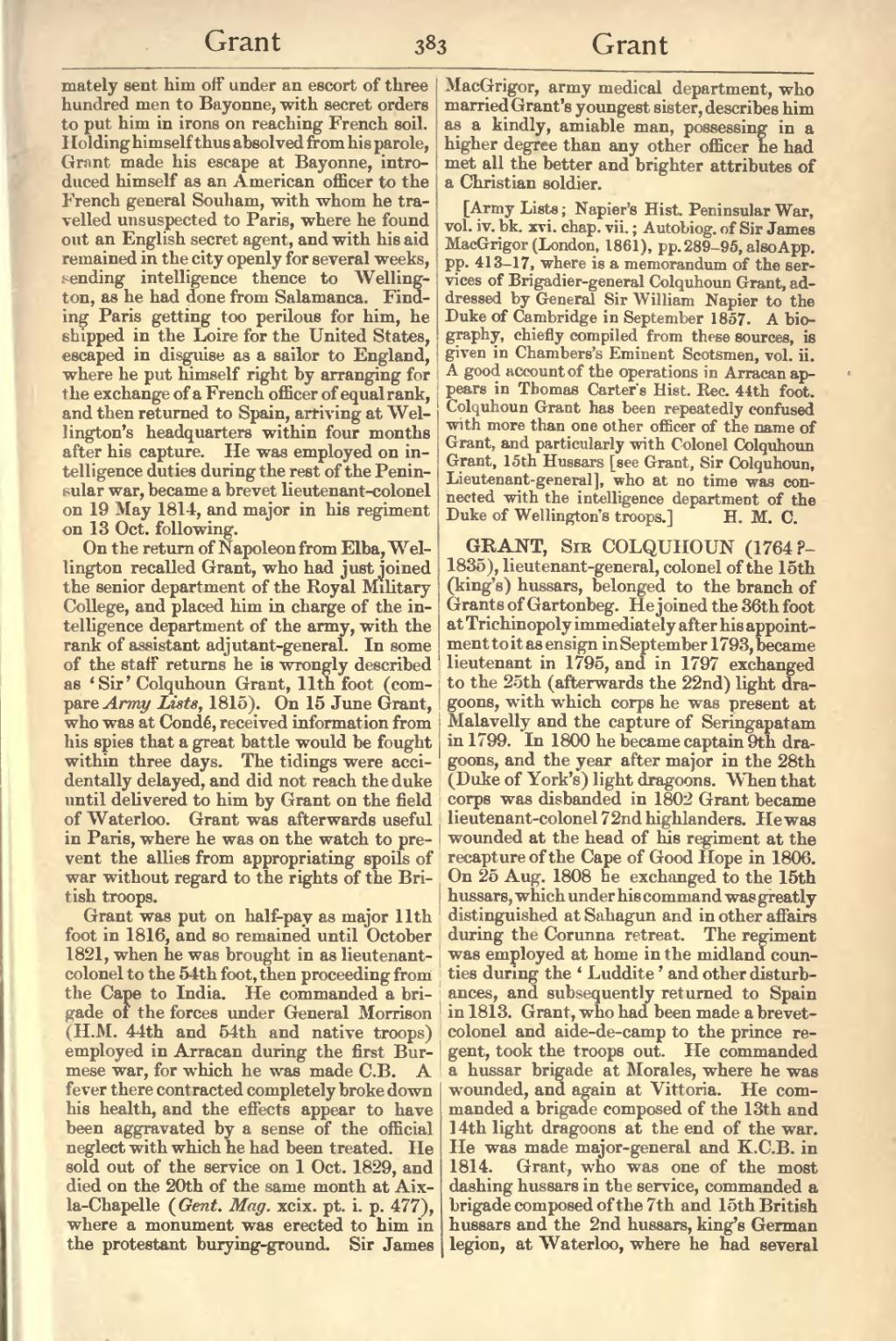mately sent him off under an escort of three hundred men to Bayonne, with secret orders to put him in irons on reaching French soil. Holding himself thus absolved from his parole, Grant made his escape at Bayonne, introduced himself as an American officer to the French general Souham, with whom he travelled unsuspected to Paris, where he found out an English secret agent, and with his aid remained in the city openly for several weeks, sending intelligence thence to Wellington, as he had done from Salamanca. Finding Paris getting too perilous for him, he shipped in the Loire for the United States, escaped in disguise as a sailor to England, where he put himself right by arranging for the exchange of a French officer of equal rank, and then returned to Spain, arriving at Wellington's headquarters within four months after his capture. He was employed on intelligence duties during the rest of the Peninsular war, became a brevet lieutenant-colonel on 19 May 1814, and major in his regiment on 13 Oct. following.
On the return of Napoleon from Elba, Wellington recalled Grant, who had just joined the senior department of the Royal Military College, and placed him in charge of the intelligence department of the army, with the rank of assistant adjutant-general. In some of the staff returns he is wrongly described as 'Sir' Colquhoun Grant, 11th foot (compare Army Lists, 1815). On 15 June Grant, who was at Condé, received information from his spies that a great battle would be fought within three days. The tidings were accidentally delayed, and did not reach the duke until delivered to him by Grant on the field of Waterloo. Grant was afterwards useful in Paris, where he was on the watch to prevent the allies from appropriating spoils of war without regard to the rights of the British troops.
Grant was put on half-pay as major 11th foot in 1816, and so remained until October 1821, when he was brought in as lieutenant-colonel to the 54th foot, then proceeding from the Cape to India. He commanded a brigade of the forces under General Morrison (H.M. 44th and 54th and native troops) employed in Arracan during the first Burmese war, for which he was made C.B. A fever there contracted completely broke down his health, and the effects appear to have been aggravated by a sense of the official neglect with which he had been treated. He sold out of the service on 1 Oct. 1829, and died on the 20th of the same month at Aix-la-Chapelle (Gent. Mag. xcix. pt. i. p. 477), where a monument was erected to him in the protestant burying-ground. Sir James MacGrigor, army medical department, who married Grant's youngest sister, describes him as a kindly, amiable man, possessing in a higher degree than any other officer he had met all the better and brighter attributes of a Christian soldier.
[Army Lists; Napier's Hist. Peninsular War, vol. iv. bk. xvi. chap. vii.; Autobiog. of Sir James MacGrigor (London, 1861), pp. 289-95, also App. pp. 413-17, where is a memorandum of the services of Brigadier-general Colquhoun Grant. addressed by General Sir William Napier to the Duke of Cambridge in September 1857. A biography, chiefly compiled from these sources, is given in Chambers's Eminent Scotsmen, vol. ii. A good account of the operations in Arracan appears in Thomas Carter's Hist. Rec. 44th foot. Colquhoun Grant has been repeatedly confused with more than one other officer of the name of Grant, and particularly with Colonel Colquhoun Grant, 15th Hussars [see Grant, Sir Colquhoun, Lieutenant-general], who at no time was connected with the intelligence department of the Duke of Wellington's troops.]
GRANT, Sir COLQUHOUN (1764?–1835), lieutenant-general, colonel of the 15th (king's) hussars, belonged to the branch of Grants of Gartonbeg. He joined the 36th foot at Trichinopoly immediately after his appointment to it as ensign in September 1793, became lieutenant in 1795, and in 1797 exchanged to the 25th (afterwards the 22nd) light dragoons, with which corps he was present at Malavelly and the capture of Seringapatam in 1799. In 1800 he became captain 9th dragoons, and the year after major in the 28th (Duke of York's) light dragoons. When that corps was disbanded in 1802 Grant became lieutenant-colonel 72nd highlanders. He was wounded at the head of his regiment at the recapture of the Cape of Good Hope in 1806. On 25 Aug. 1808 he exchanged to the 15th hussars, which under his command was greatly distinguished at Sahagun and in other affairs during the Corunna retreat. The regiment was employed at home in the midland counties during the 'Luddite' and other disturbances, and subsequently returned to Spain in 1813. Grant, who had been made a brevet-colonel and aide-de-camp to the prince regent, took the troops out. He commanded a hussar brigade at Morales, where he was wounded, and again at Vittoria. He commanded a brigade composed of the 13th and 14th light dragoons at the end of the war. He was made major-general and K.C.B. in 1814. Grant, who was one of the most dashing hussars in the service, commanded a brigade composed of the 7th and 15th British hussars and the 2nd hussars, king's German legion, at Waterloo, where he had several
